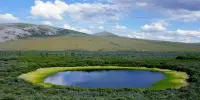How is the weather changing as a result of global warming? Climate archives provide valuable insights into past climate changes, particularly the processes that propel our planet from one climate setting to the next. However, for humans and ecosystems, time spans ranging from weeks to years, which are the scope of weather events, are frequently the most important.
These two aspects have now been merged, and the effects of the most recent global warming on seasonal temperature fluctuations have been described, using an analytical method developed and tested at MARUM – Center for Marine Environmental Sciences at the University of Bremen. The findings have been published in the scientific journal Nature.
Algae fossil remains accumulate in marine sediments over time and can be used to reconstruct past oceanic conditions. Lipid biomarkers, which are molecular fossils, are especially important for this. They are the cellular building blocks of algae that once inhabited the oceans. When algae die and sink to the ocean floor, the information contained in their lipids about the environmental conditions during their lives is preserved. Analyses of these types of climate archives have provided fundamental information that has aided our understanding of past climate changes in recent decades.
The Holocene, our current epoch, was brought about by the warming that occurred 11,700 years ago. More warming is now ushering us out of the Holocene and into the Anthropocene, which is defined by anthropogenic climatic warming and environmental changes.
Kai-Uwe Hinrichs
A special tool for hidden details
Very special laminated sediment archives are formed in specific locations, such as the Cariaco Basin off the coast of Venezuela. “The Cariaco Basin deposits are unique in that they preserve thousands of years of well-sorted seasonal records, including a thin layer for each summer and one for each winter. Thus, the archive contains fundamental information about past short-term climate fluctuations in the tropics that was previously undecipherable “Dr. Lars Wörmer of MARUM is the first author.
He and his colleagues compare this situation to the fine print encountered in some documents, the reading of which may require the help of special devices. In the case of the sediments, the ‘reading aid’ is a laser coupled with an especially powerful mass spectrometer, which allows them to determine the distribution of lipid biomarkers in each one of the millimeter-thick layers.
Prof. Kai-Uwe Hinrichs, whose working group developed the method, describes it as “a tool to decode previously hidden details in climate archives.” Hinrichs and his colleagues have developed a molecular imaging technique to map the climatic and environmental processes of the Earth’s recent history at a high temporal resolution, i.e., almost in monthly intervals, in a project funded by the European Research Council (ERC). Other analytical methods are used to reliably map intervals of hundreds or thousands of years, which, given the Earth’s history of more than four billion years, is already considered very detailed.

Global changes affect local temperatures
The study spans a recent period in Earth’s history that was marked by significant, abrupt warming that was not caused by humans. “This is seen as a parallel to today,” Lars Wörmer explains.
“The Holocene, our current epoch, was brought about by the warming that occurred 11,700 years ago. More warming is now ushering us out of the Holocene and into the Anthropocene, which is defined by anthropogenic climatic warming and environmental changes.” The tropical ocean’s temperature difference between summer and winter doubled during this period, according to Kai-Uwe Hinrichs, Lars Wörmer, and their colleagues. This demonstrates how global climate change affects seasonal temperature variations at the local level.
A MARUM study based on the new method was published in Nature Geosciences in September. This study produced data that revealed the history of sea-surface temperature with a resolution of one to four years. Dr. Igor Obreht and his colleagues investigated a sediment core from the eastern Mediterranean that documented temperatures from the last interglacial period in it (from around 129,000 to 116,000 years ago). Obreht and colleagues’ research thus focused on the last time temperatures were warmer than they are now.














